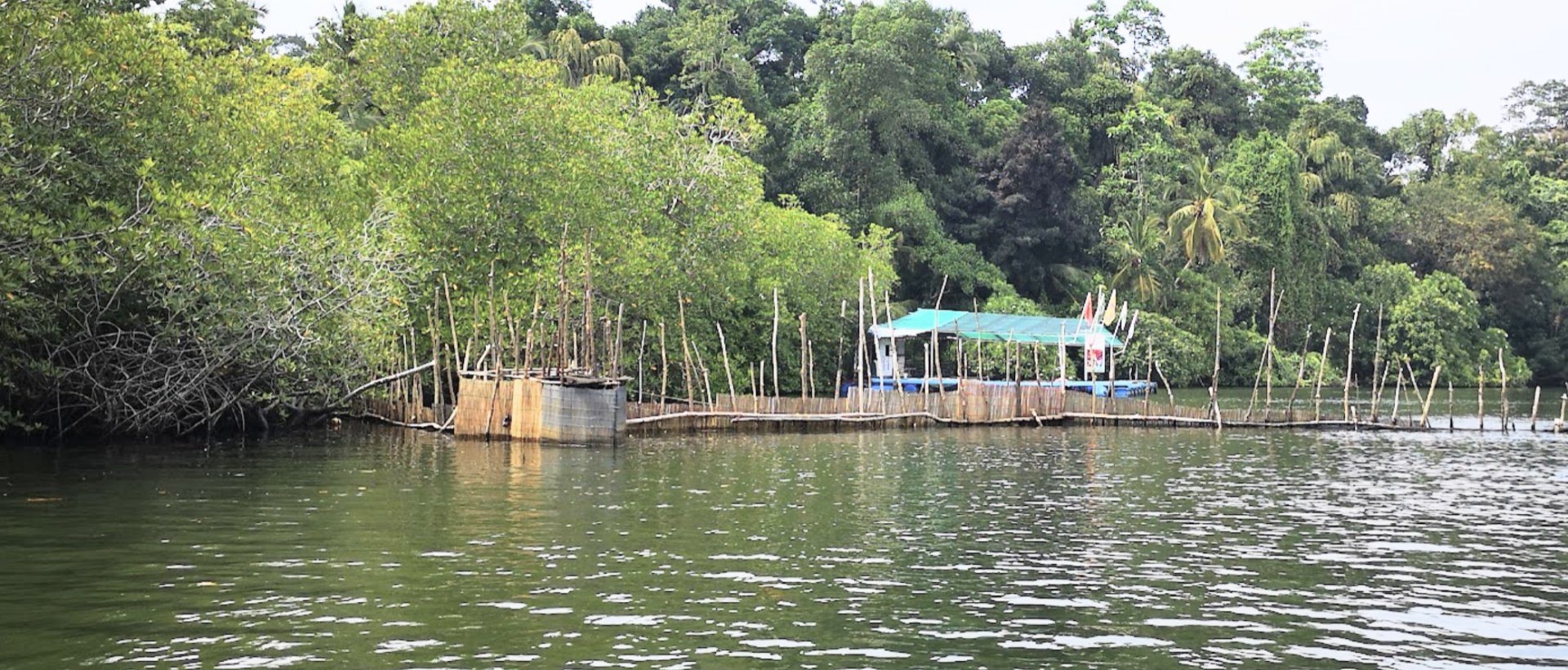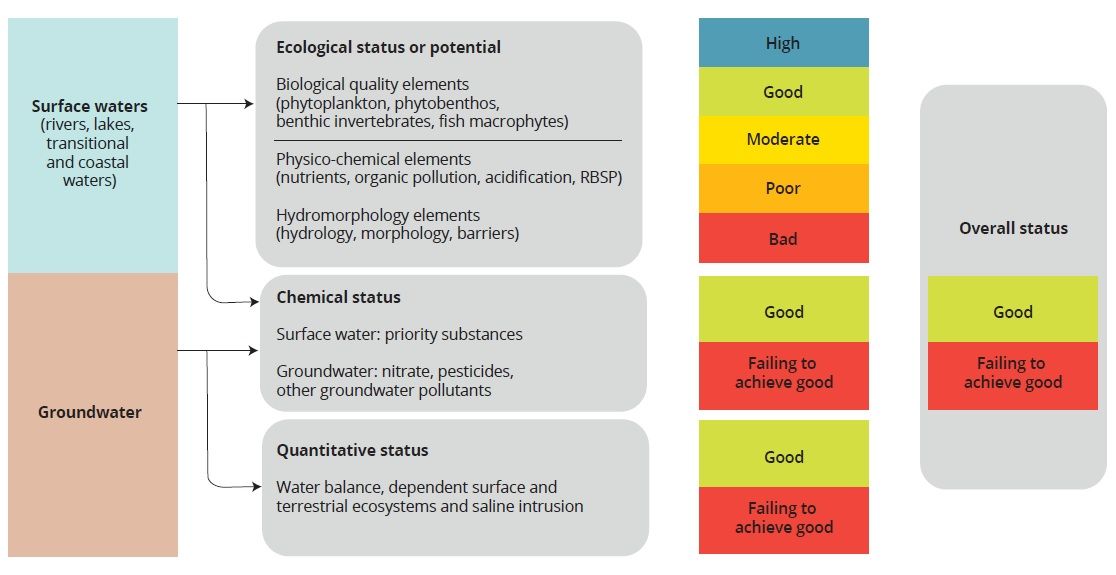
MOOC: Auditing Water Issues
1.1. Good status of water and pressures affecting it
Good status of water
A number of criteria are used by governments and agencies around the world to assess the quality, quantity and hydrological regime of water resources with the purpose to protect both human health and the environment.
In the European Union, the good status of surface waters and groundwater are commonly defined in the Water Framework Directive []. For surface water (rivers, lakes, marine waters), ecological status and chemical status are important in assessing whether the overall status is good. For groundwater, chemical status and quantitative status must both be at least good to ensure that the overall good status would be achieved.

Figure 5. Assessment of status of surface waters and groundwater according to the WFD
Source: European Environment Agency
The Water Framework Directive will be covered in the next module (2.4).
Pressures affecting the good status of water
When talking about problems related to water, we need to understand the pressures that affect the good status of water.
Pressures can originate from point or diffuse sources. Point sources of pollution are single and identifiable. Point sources that place pressure on surface water are usually plants or farms. When contaminated water seeps from the point source into groundwater, leakage is usually the reason. Diffuse pollution originates from a range of dispersed urban and rural activities. An example of diffuse pollution is the penetration of nutrients into water bodies or groundwater as a result of over-fertilisation of fields.

Figure 6. Point and diffuse sources of water pollution []
Water can also be abstracted either from surface or groundwater, thus creating pressure on the quantity of water resources.
Water flow regulation and morphological alteration causes pressure on surface water, e.g. creating dams on rivers prevents migration of fish.
Artificial recharge of groundwater (injecting water into the ground in a controlled way) is a pressure that may originate from mining activities or other major industries.
Saltwater intrusion into groundwater typically occurs due to the pumping of freshwater from wells close to the sea. Therefore, drinking water aquifers become contaminated by salt water.
Table 1. Pressures affecting the good status of water
|
SOURCE CLASSIFICATION |
EXAMPLES OF SOURCES |
|
DIFFUSE SOURCES | |
|
urban drainage (including runoff) | industrial/commercial estates urban areas (including sewer networks) airports trunk roads railway tracks and facilities harbours |
|
agriculture diffuse | arable, improved grassland, mixed farming crops with intensive nutrient or pesticide usage or long bare-soil periods (e.g. corn, potato, sugar beets, vine, hops, fruits, vegetables) over grazing – leading to erosion horticulture, including greenhouses application of agricultural waste (esp. manure) to land |
|
forestry | peat mining planting/ground preparation felling pesticide applications fertilizer applications drainage oil pollution |
|
other diffuse | sewage sludge recycling on land atmospheric deposition dredge spoil disposal into surface waters shipping/navigation |
|
POINT SOURCES | |
|
wastewater | municipal wastewater, primarily domestic municipal wastewater with a major industrial component storm water and emergency overflows private wastewater, primarily domestic private wastewater with a major industrial component harbours |
|
industry | gas/petrol chemicals (organic and inorganic) pulp, paper and boards woollens/textiles iron and steel food processing brewing/distilling electronics and other chlorinated solvent users wood yards/timber treatment construction power generation leather tanning shipyards other manufacturing processes |
|
mining | active deep mine active open cast coal site/quarry gas and oil exploration and production peat extraction abandoned coal (and other) mines abandoned coal (and other) mine spoil heaps (bings) tailings dams |
|
contaminated land | old landfill sites urban industrial sites (organic and inorganic) rural sites military sites |
|
agriculture point | slurry silage and other feeds sheep dip use and disposal manure depots farm chemicals agricultural fuel oils agricultural industries |
|
waste management | operating landfill sites operating waste transfer stations, scrap yards, etc. application of non-agricultural waste to land |
|
aquaculture | land-based fish farming / watercress / aquaculture marine cage fish farming |
|
manufacture, use and emissions from all industrial/agricultural sectors | priority substances all industrial/agricultural sectors’ priority hazardous substances other relevant substances |
|
ABSTRACTION | |
|
reduction in flow | abstractions for agriculture abstractions for potable supply abstractions by industry abstractions by fish farms abstractions by hydro-energy abstractions by quarries/open cast coal sites abstractions for navigation (e.g. supplying canals) |
|
ARTIFICIAL RECHARGE | |
|
| groundwater recharge |
|
MORPHOLOGICAL | |
|
flow regulation | hydroelectric dams water supply reservoirs flood defence dams diversions weirs |
|
river management | physical alteration of a channel engineering activities agricultural enhancement fisheries enhancement land infrastructure (road/bridge construction) dredging |
|
transitional and coastal management | estuarine/coastal dredging marine constructions, shipyards and harbours land reclamation and polders coastal sand renewal (safety) |
|
other morphological | barriers |
Based on the Common Implementation Strategy for the Water Framework Directive (2000/60/EC). Guidance Document No. 3, Table 4.2, pg 53 cited at: https://circabc.europa.eu/sd/a/7e01a7e0-9ccb-4f3d-8cec-aeef1335c2f7/Guidance%20No%203%20-%20pressures%20and%20impacts%20-%20IMPRESS%20(WG%202.1).pdf
The effect of pressures varies on different water bodies. The table 2 below provides some examples about the effects of different pressures on water bodies.
Table 2. Analysis of Pressures and Impacts. Pressures to be considered
|
Pressure |
Water Body Category | |||
|
Rivers |
Lakes |
Coastal/Transitional |
Groundwater | |
|
Household |
X |
X |
X |
X |
|
Industry (operating, historical) |
X |
X |
X |
X |
|
Agriculture |
X |
X |
X |
X |
|
Forestry |
X |
X |
X |
X |
|
Mines, quarries |
X |
|
|
X |
|
Transport |
X |
|
X |
|
|
Flow regulation works |
X |
|
X |
|
|
Hydropower works |
X |
|
X |
|
|
Urban settlements |
X |
X |
X |
|
|
Flood protection |
X |
|
X |
|
|
Fishing/angling |
X |
X |
X |
|
Based on the Common Implementation Strategy for the Water Framework Directive (2000/60/EC). Guidance Document No. 3, Table 4.1, pg 53 cited at: https://circabc.europa.eu/sd/a/7e01a7e0-9ccb-4f3d-8cec-aeef1335c2f7/Guidance%20No%203%20-%20pressures%20and%20impacts%20-%20IMPRESS%20(WG%202.1).pdf
 THINKING EXERCISE
THINKING EXERCISE
What are three major pressures related to water in your country?
Mark all activities that have an impact on surface water:
Water-related problems are closely linked to other topics, as the problem ‘travels with water’. When sewage water is drained directly into a water body it affects the whole aquatic environment downstream. Therefore, in order to understand the origin and the consequences of the problem, auditors need to find all related topics and decide whether or how these need to be reflected in the audit. Below is an audit example from SAI of Albania, which audited the ecosystem of Prespa National Park, focusing on water resource management in addition to forest management and illegal fishing.
 AUDIT CASE: Audit case: Preservation of the Prespa National Park Ecosystem
AUDIT CASE: Audit case: Preservation of the Prespa National Park Ecosystem
This case study from SAI Albania is part of the performance audit on the preservation of the Prespa National Park ecosystem, where water resource management and pollution of the two lakes of Prespa (part of this park) from the sewage of 6,000 inhabitants living in this park are widely treated.
|
Audit questions |
Source of criteria |
|
Has the Management Plan for the Water Basin of Prespa Lakes been drafted? |
Law no. 111/2012 ‘For integrated management of water resources’ |
|
How is the sewage generated by private or public entities managed? |
Law no. 9115/2003 ‘For environmental treatment of polluted waters’ |
|
Have the water resources been rented for utilization from NAPA (National Agency of Protected Areas) and if so, how has it been monitored? |
Decision no. 547/2009 ‘For the determination of procedures and values of rent for water surfaces, for the utilization of intensive aquaculture activity’; |
|
Is there any data on the exact number of water wells owned by Prespa Park residents and how many are equipped with the exploitation authorization for these wells? |
National legislation (provisions regarding the water wells register kept by the Directory of Water Resources Policies).
|
The audit concluded that the objectives of Prespa ecosystem conservation have not been reached as all the wastewater generated by residents and businesses ended up in the lakes. The audit report indicated the need for a long-term solution.
Essential elements of each audit are audit questions and criteria, which are developed in the planning phase of auditing.
You can review how to prepare audit questions and criteria in the MOOC ‘Introduction to Environmental Auditing in the Public Sector‘.


